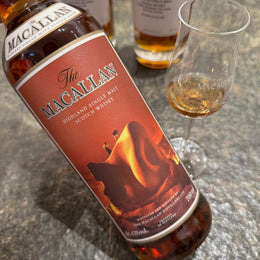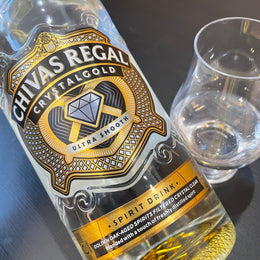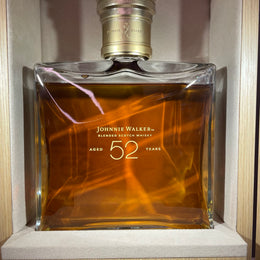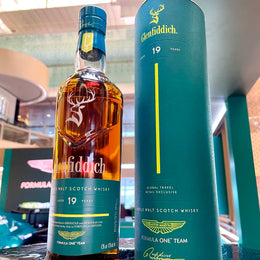Staoisha 2013, 8 Years Old, Heavily Peated Bunnahabhain Single Malt, bottled by Malt, Grain & Cane, 56.9% ABV


In a small village along the northeastern coast of Islay sits Bunnahabhain Distillery whose reputation precedes that of its birthplace. On a fair weather day, nothing much seems to happen in this hamlet, apart from the gentle lapping waters against the dark pebbles of the shore.

Bunnahabhain is one of only two Islay distilleries (besides Bruichladdich) that sing an opposite tune to the legacy of heavy peatiness that Islay malts are internationally famous – or notorious – for. Most bottles of single malts from Bunnahabhain are almost entirely unpeated.
The distillery's sources of water are from the nearby Margadale Spring and the Loch Staoisha a few minutes' drive from the distillery.

The distillery has some of the tallest pot stills in Islay with wide-angled lyne arms that result in a fairly steep path of ascent for vapours (see diagram below).

This may be the reason why the distillery is said to produce a fairly approachable spirit with a light texture and sweet citrusy notes in its profile.
The Victorian distillery traditionally aged its malt in ex-Sherry casks which adds a rich, red fruit sweetness to the spirit, with often a hint of ginger and a mild salty edge.
Staoisha-labelled whiskies...
...are actually Bunnahabhains in thin disguise.

Whispers within the whisky community suggest that Bunnahabhain has been experimenting with varying levels of peat. Funnily enough, the distillery's management was a little absent-minded in managing production. Apparently, this caused them to end up with too much heavily peated whisky that the management felt was misaligned with Bunnahabhain's brand focus on unpeated or very-mildly-peated whisky.
As a result, much of the heavily peated distillate was sold off to independent bottlers. And rather than labelling the distillate "Bunnahabhain", the distillery prefers to use codenames like "Staoisha" (pronounced stow-ee-sha) for its peated whisky.
So, "Staoishas" are only offered by independent bottlers, not as original bottlings from Bunnahabhain itself.
Staoisha bottlings tend to be on the younger side at around 4 to 5 years old and are usually casked in bourbon barrels. While fairly young, a recent series of Staoisha bottlings stated to have been matured in dechar / rechar refill hogshead casks have been making the rounds, and received pretty good reviews by the peat lovers I know.

I have with me today another Staoisha in a striking blue label bottled by Malt, Grain & Cane (read our interview with these folks here). This was distilled in 2013 and bottled just recently in April 2022, and had spent 8 years in an ex-bourbon barrel, then bottled at cask strength at 56.9% ABV.
At 8 years, this is actually a slightly more mature Staoisha in the market.
A little segue back to the distillery's story: just last year, the distillery replaced its master distiller with Brendan McCarron, who has amassed years of experience managing Lagavulin, Caol Ila and then Ardbeg – where he spent much of his time working with the respected Dr Bill Lumsden of The Glenmorangie Company.

Brendan McCarron's appointment also marks a shift in the distillery's focus from just producing spirit to better cask management practices. So, I strongly suspect that after they figure out more things to do with their spirit, Bunnahabhain may well begin tightening its supply of Staoisha to outsider independent bottlers. We may well see a dwindling supply of Staoisha in the next years.
Point is that these Staoishas probably aren't here to stay forever!
So let's get to tasting this bottle.
Staoisha 2013, 8 Years Old, Heavily Peated Bunnahabhain, bottled by Malt, Grain & Cane, 56.9% ABV - Review

Colour: Sunflower oil.
On the nose: Opens with gentle salinity and smokiness – mildly reminiscent of smoked salmon.

Smokiness intensifies to a dryer ashiness, while accompanied by a classic Islay chalkiness and salinity of sea spray.

Behind the curtain of smoke and brine is a crisp, sweet, fruity core. The honeyed crisp sweetness accompanied by a mildly herbaceous smokiness that reminds me of canned chrysanthemum tea. The dram grows in fruity notes, we get stewed apples accompanied by the tartness of apple cider vinegar, fresh raspberries and pinot noir.

On the palate: Bright, lively, crisp and creamy. The first sip brings out a decent sweetness accompanied by an unexpectedly smooth layer of ashy smoke. There is a touch of salinity reminiscent of thin sliced prosciutto which accompanied by the sootiness gives an impression of charred meats.

A second or two brings out mild herbal notes reminiscent of Chinese herbal dessert soups – we have cooked Longan, dates, wolfberries and a light syrupy note. And as the herbal notes fade, brightness and acidity come through to present fruitier notes of honey lemon hard candies and cherries. Once again, the vibrance feels to be in tune with freshly uncorked red wine.

As richer notes fad, a dry chalky minerality start to show. Mildly flinty with a aroma of wet gravel.

The finish: Medium length with fading notes of apple sweetness and a growing brininess of smoked salmon and coastal minerality. Rounded up by a dry chalkiness.

My Take
This Staoisha has the finesse of a properly aged Islay malt and a lively bounciness seen in the young Nikka Taketsuru (I actually prefer the NAS Taketsuru over aged ones) and some Clynelish expressions. It's also highly drinkable.
If balance is what you enjoy – as opposed to straight up Islay peat bombs like other "heavily peated" expressions – this precocious 8 year old exhibits a nice balanced trinity of (a) crisp, lively fresh orchard fruits, (b) mineral brininess and (c) a gentle layer of Islay smoke that offers some cushion from the "bite" of a cask strength ex-bourbon malt. Interestingly, the cask influence does not verge on woodiness – I can't find a hint of vanilla or oak in this.
Blind tasting this, I would have guessed this was at least a 12 to 14 year old Scotch. Which leads me to wonder if this batch is similarly subject to the magic of those dechar / rechar casks that have an effect of aging these whiskies slightly faster as virgin oak casks do.

Essentially, this process involves "decharring" a used cask scraping off the inner charred walls to reveal fresh, active oak underneath, then "recharring" the cask with another round of fire. This activates the cask without exposing the whisky to too much harsh tannins found in virgin oak. It's similar to the Shave/Toast/Rechar (STR) process pioneered by the late whisky expert Dr Jim Swan.
My Rating |
🍹 An uncomplicated cocktail of fresh fruits and gentle peat smoke that surprises with its maturity and drinkability at cask strength. One of those Long Island Teas. Try giving this to peat virgins ;) |
At the moment, this is available at most whisky bars in Singapore and I believe in a couple of bars in Jakarta, Indonesia. It's also available for delivery directly from Malt, Grain & Cane here.

@CharsiuCharlie








